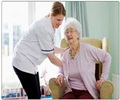A study in JAMA reveals that the use of an energy-absorbing hip protector does not do much to prevent hip fractures in elderly residents.
“In the United States, nearly 340,000 hip fractures occur per year, more than 90 percent of which are associated with falls, and the number of hip fractures may double or triple by the middle of this century. The highest incidence rates of hip fractures have been reported in nursing home residents, where 50 percent of residents fall each year,” the authors write. Hip protectors have been developed to reduce the impact of falls and risk of hip fractures.Previous studies regarding their effectiveness have had conflicting results. Douglas P. Kiel, M.D., M.P.H., of Hebrew SeniorLife and Harvard Medical School, Boston, and colleagues conducted a randomized controlled trial from October 2002 to October 2004 to test the effectiveness of an energy-absorbing and energy-dispersing hip protector in reducing the incidence of hip fracture among nursing home residents.
The trial included 37 nursing homes in which 1,042 residents (average age, 85 years; 79 percent women) wore a hip protector on 1 hip only so that each participant served as his or her own control. The average duration of participation for nursing home residents was 7.8 months. The hip protector consisted of an outer layer of polyethylene backed by a hard high-density polyethylene shield that was backed by ethylene vinyl acetate foam. Overall adherence of the participants was 73.8 percent.
After a 20-month follow-up, the study was terminated due to a lack of effectiveness. The researchers found that the incidence rate of hip fracture on protected hips (3.1 percent) did not differ from the incidence rate on unprotected hips (2.5 percent). Similarly, in analysis for the 334 residents with greater than 80 percent adherence, the incidence of hip fracture on protected hips (5.3 percent) did not differ from that on unprotected hips (3.5 percent).
“In summary, this large multicenter clinical trial failed to demonstrate a protective effect of a hip protector on hip fracture incidence in nursing home residents despite high adherence, confirming the growing body of evidence that hip protectors are not effective in nursing home populations.
With the development of better pad materials and more thorough testing, future studies should examine new hip protectors using nonclustered randomized designs like ours to avoid many methodological biases,” the authors write.
Advertisement
LIN/C






